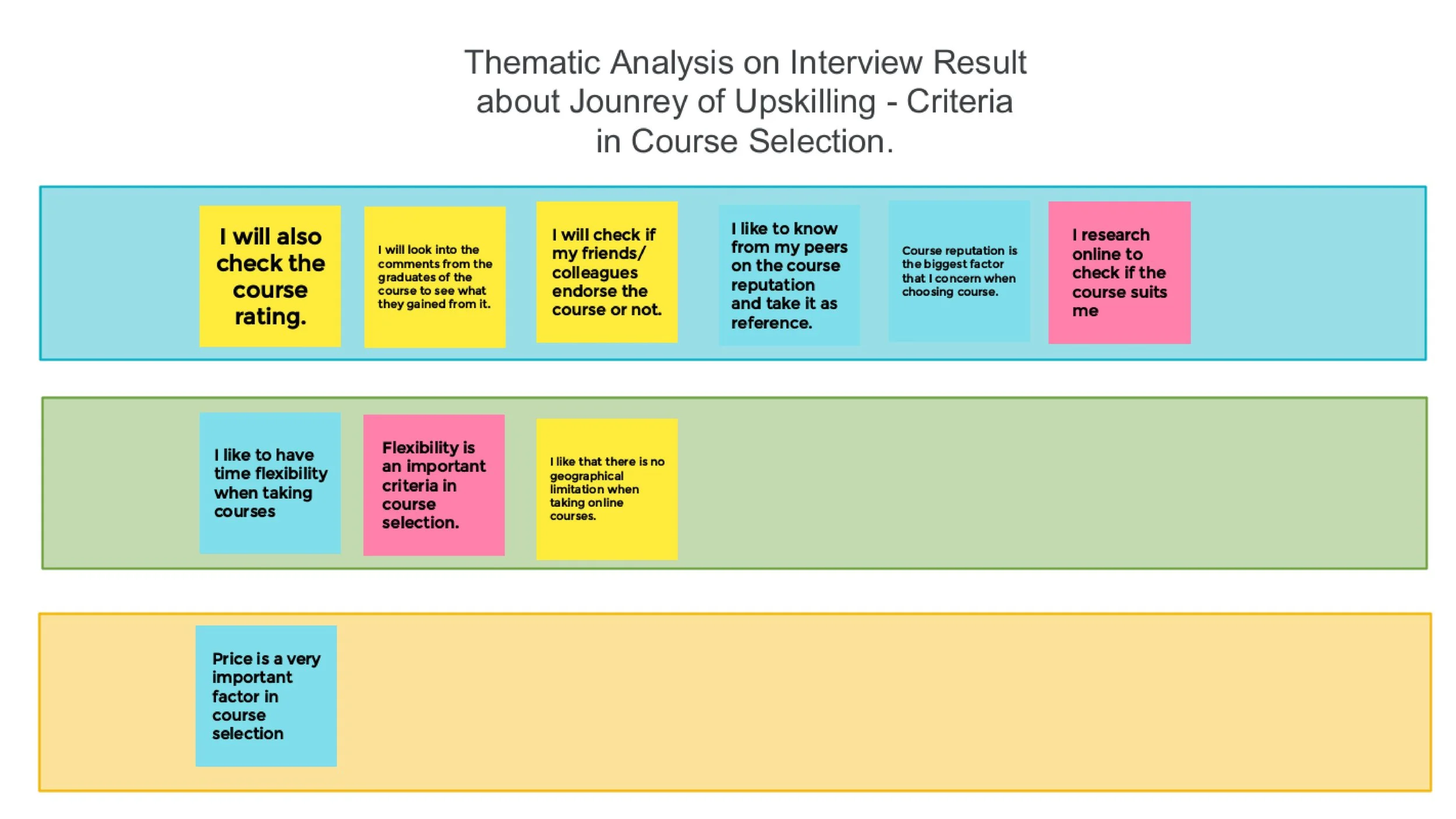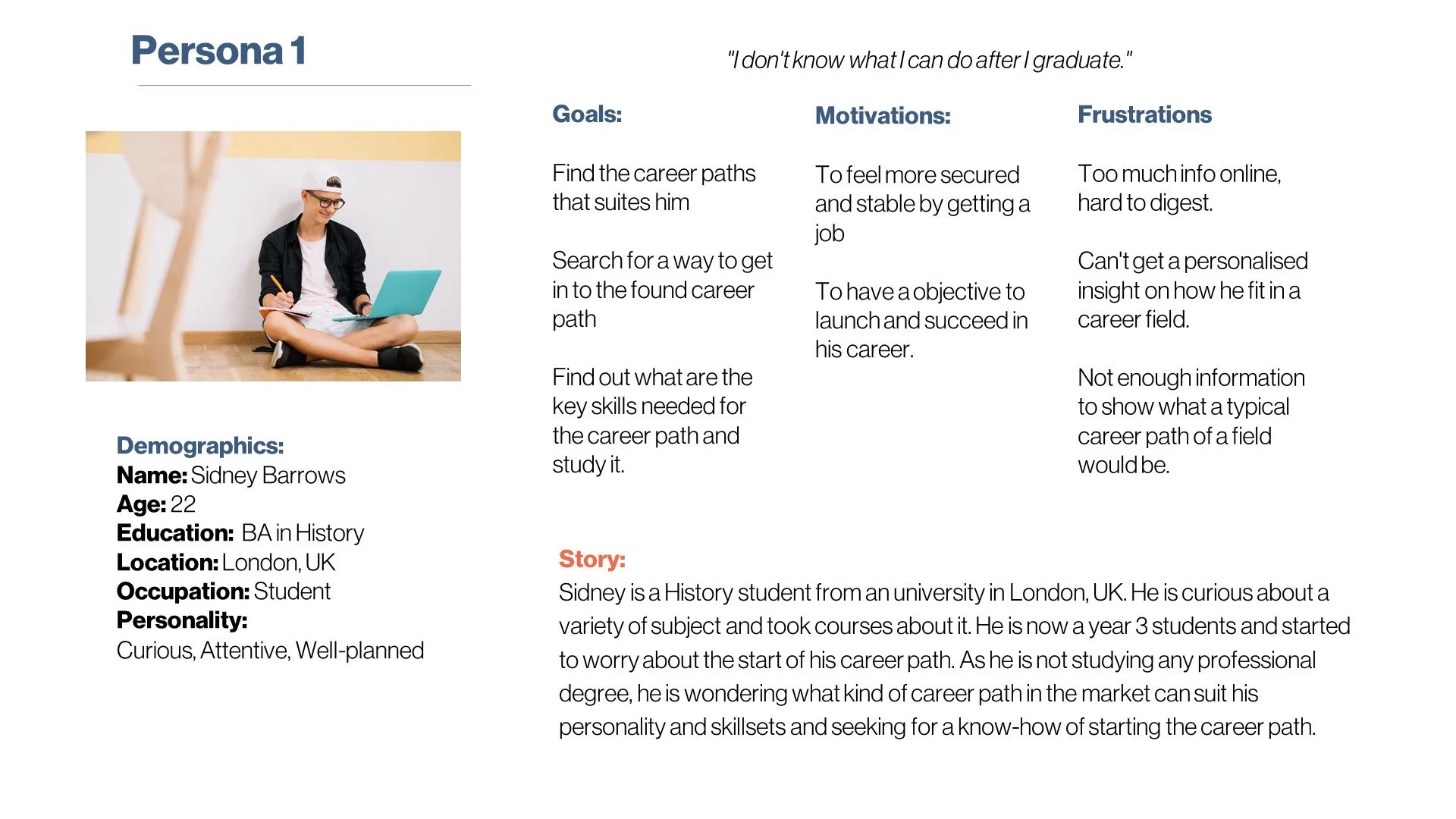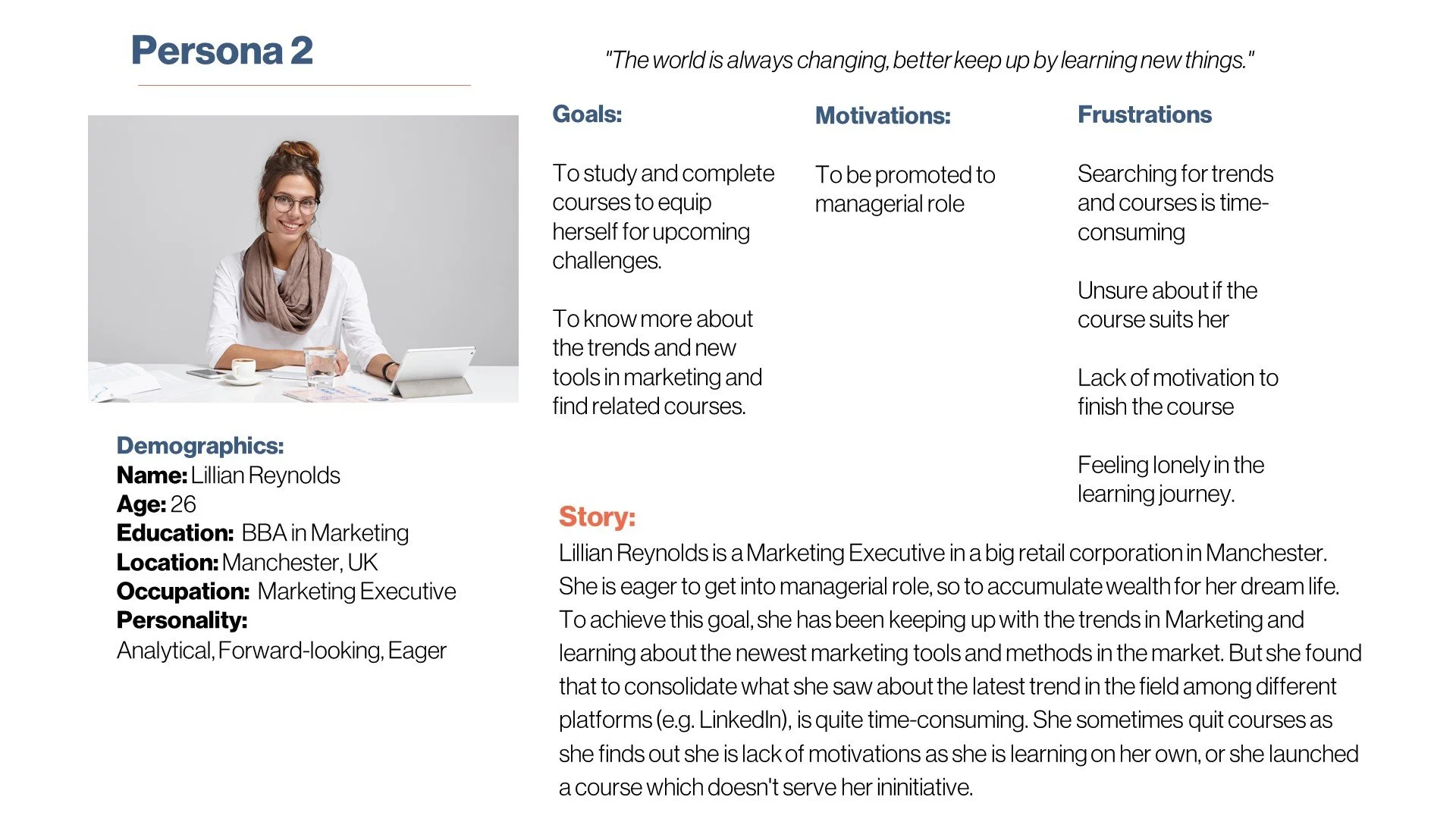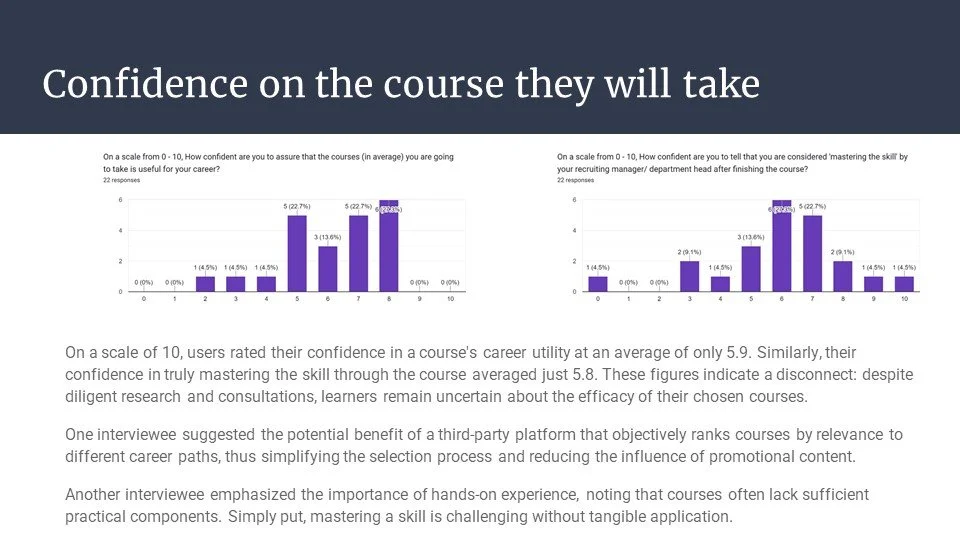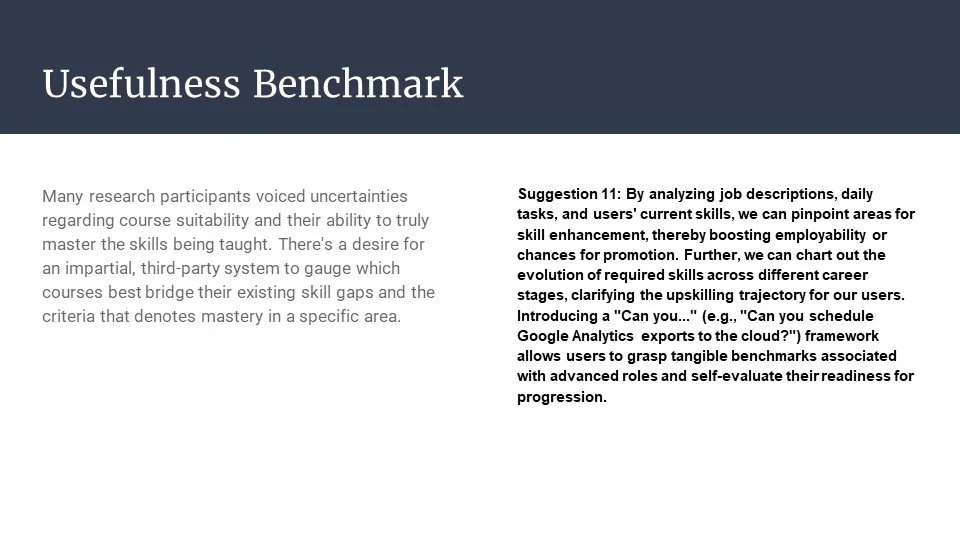Understanding your Upskilling Journey
Motivations, Plans, Pain Points and Self-Assessment
My Role: User Research Intern (Sept 2023 - Now)
Project for : Superpower
Deliverables:
• Research report with insights
• 3 in-depth interviews
• Survey with 27 valid replies
• 2 personas
• User flow
• Low-fidelity prototype
Outcomes:
• UX research to help identify key tasks for product design of a upskilling solution
Background:
Superpower, previously known as Workfinder, has evolved into a dynamic platform tailored for fresh graduates, career switchers, and the general workforce. It's designed to facilitate the discovery of relevant upskilling courses and diverse employment opportunities, including internships and paid positions. Having established a solid foundation, Superpower is now strategizing its next developmental phase.
At the heart of their mission is the ambition to be "the user’s lifelong upskilling partner." This goal is underpinned by two primary strategies identified from prior research:
Personalized Upskilling Pathways: Crafting individualized learning journeys that align with each user's career aspirations and skill requirements.
Continuous Skill Insights: Offering ongoing insights into skill development, ensuring users remain equipped for lifelong learning and career progression.
These strategies position Superpower not just as a platform, but as a continual growth companion in the evolving professional landscape.
Task:
The assignment involves a comprehensive analysis of the user upskilling journey, identifying challenges users face, and devising solutions that resonate with Superpower’s objectives. This process aims to craft distinct strategies that set Superpower apart from established e-learning platforms like Coursera and Udemy, and recruitment sites such as LinkedIn and Indeed. The goal is to create a unique market position for Superpower, offering innovative and tailored solutions in the field of professional development and upskilling.
Constraints:
Quick Turnaround. Given the tight four-week deadline, amounting to roughly 40 man-hours, I had to streamline the traditional research process to meet the project's requirements. This entailed prioritizing essential research activities and clear communication with stakeholders. Consequently, some aspects of the conventional research plan were condensed to deliver focused and straightforward findings promptly. In the project's later stages, I supplemented the initial research with additional materials to provide a comprehensive view, ensuring that other researchers and stakeholders received a thorough understanding of the findings.
My approach to the task:
Recognizing the individual variations in learning and upskilling, I initiated my research with a secondary analysis to identify common learning patterns. This led to the delineation of four key stages in a user's learning cycle:
Evaluating: Users assess their skill levels.
Planning: Identification of skill gaps and prioritizing the learning journey.
Searching: The process of course selection, comparison, and decision-making.
Learning: Engagement and completion of the chosen course.
This framework of understanding learner behavior was instrumental in defining the research scope. The approach began with specific questions aimed at helping the client comprehend the research direction and maintain focus.
With these stages outlined, I crafted interview and survey questions that delved into the users' experiences, future plans, challenges, and evaluation methods at each stage. I adopted a hybrid questioning style, probing both their actions (what they did or plan to do) and perceptions (what they think), to mitigate social desirability bias.
To align with our business stakeholders and preempt any potential conflicts in interpreting the research findings, I presented this methodology during our weekly standup, securing their early agreement on the research scope and methodology. Post-approval, I commenced data collection, leveraging Superpower’s member base and employing snowball sampling through my social network. This effort yielded 27 survey responses and 3 comprehensive interviews over two weeks, using platforms like Microsoft Teams and Google Meeting. With this data in hand, I was prepared to move into the synthesis phase.
Data Processing
Interview
Post-interview, I focused on meticulously reviewing the recorded sessions. This involved replaying each interview to capture key insights and observations made by the interviewees. These notes were then systematically organized into an affinity map, a tool that helped in categorizing and synthesizing the data to identify patterns, themes, and emerging trends from the conversations.
Survey
For the survey data, I utilized Google Sheets’ in-built visualization features for an initial, straightforward analysis of the responses. This provided a quick, visual grasp of the data trends and patterns across various questions. To delve deeper, I exported the survey data for cross-tabulation analysis. This advanced approach allowed me to examine the data from multiple angles, particularly focusing on understanding the diverse behaviors and attitudes of users regarding their upskilling journey. This multi-layered analysis was crucial in gaining a comprehensive understanding of the user's perspectives and experiences in upskilling.
Some Key Insights
The data gathered from the research presents intriguing insights into user behavior and needs in the context of upskilling:
High Demand for Skill Assessment Tools: A significant 90% of users express a desire for a platform that enables them to assess their skills from various perspectives. This underscores a strong market need for comprehensive skill evaluation features, suggesting that users are seeking deeper self-awareness and guidance in identifying their learning paths.
Uncertainty in Course Relevance: 42% of participants indicated uncertainty about whether course content aligns with their specific needs before enrollment. This highlights a gap in the market for more personalized course recommendations or previews, which could help users make more informed decisions about their learning choices.
Lack of Structured Upskilling Plans: Approximately 26% of participants do not have a planned approach to upskilling, often beginning to learn only when they face unfamiliar tasks. This suggests an opportunity for Superpower to offer tools or services that assist users in creating structured learning plans, potentially increasing engagement and effectiveness in learning.
Career Advancement as a Primary Motivator: With 65% of participants identifying career advancement as their main reason for upskilling, there's a clear indication that users are looking for courses that directly contribute to their professional growth. This points towards the potential of developing a career-oriented product, one that not only provides learning opportunities but also aligns them with career progression goals.
These insights can inform the development of Superpower's platform, emphasizing the creation of features that cater to these specific user needs and preferences, thereby positioning the platform as a unique and valuable resource in the competitive field of online learning and professional development.
Knowing who our users are
To effectively illustrate the research findings and identify pain points, I synthesized the data into two distinct user personas. These personas are designed to encapsulate the key insights and represent the diverse user needs and challenges within our target audience.
Knowing their Journey
After identifying the personas, I meticulously chart the end-to-end experience of the user, capturing their interactions, emotions, and challenges at each touchpoint in our user journey map. This process is vital for empathetically understanding the user's perspective, identifying pain points, and uncovering opportunities for improvement. By mapping the user's journey, we gain a holistic view of their experience, enabling us to design solutions that are not only functional but also resonate deeply with the user's needs and expectations. This approach ensures that our designs are user-centric, enhancing user satisfaction and engagement.
Ideation
Having identified key business opportunities, I initiated the ideation phase. Given the multitude of opportunities pinpointed earlier, my first step involved consolidating a list of potential features. I then engaged in a creative process of mixing and matching various component combinations to design an intuitive and logical dashboard and navigation flow. This approach ensured that the final design was not only innovative but also aligned with our identified business objectives. I employed several ideation techniques to foster creativity and innovation. Techniques like crazy 8 and mind mapping helped in exploring a wide range of possibilities. Each feature was scrutinized for its potential impact on user experience and business value. The ideation process had yielded a well-defined set of features, ready to be translated into detailed designs and development plans.
Wireframes
To enhance the presentation of my concepts, I crafted basic wireframes that accompany the research report. These wireframes visually represent the insights and product ideas derived from the research, providing a cohesive and comprehensive view of the findings.
Final Report
The final research report consolidates the research initiative, methodology, analytical progression, insights, and product concepts inspired by the study. It incorporates visualizations and wireframes, ensuring that various stakeholders share a common understanding of the research findings. This report enables stakeholders and fellow researchers to effortlessly grasp a comprehensive overview of the research.

